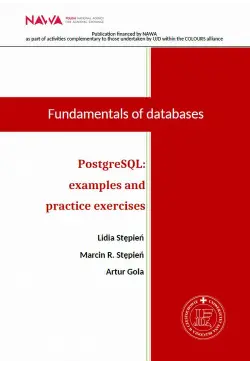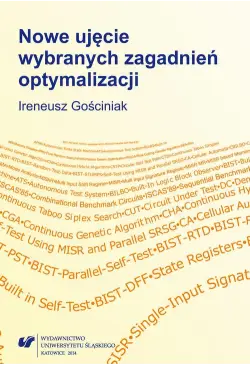
- Za darmo
ebook Fundamentals of databases PostgreSQL: examples and practice exercises
Odkryj Fundamentals of databases PostgreSQL: examples and practice exercises - ebook, który otwiera drzwi do zrozumienia podstawowych pojęć i praktycznych umiejętności w zakresie baz danych relacyjnych. Autorzy Lidia Stępień, Marcin R. Stępień oraz Artur Gola zapraszają Cię do fascynującej podróży po świecie zarządzania danymi. Opublikowany w 2024 roku przez Uniwersytet Jana Długosza w Częstochowie, ten anglojęzyczny ebook jest doskonałym wyborem dla każdego, kto chce pogłębić swoją wiedzę na temat baz danych relacyjnych, skupiając się na PostgreSQL - jednym z najpopularniejszych systemów zarządzania bazami danych na świecie.
Wykorzystując format PDF, ten ebook do pobrania oferuje bogato ilustrowane przykłady oraz praktyczne ćwiczenia, które pozwolą Ci rozwinąć umiejętności niezbędne do efektywnego korzystania z języka SQL (Structured Query Language). Nauczysz się tworzyć i modyfikować tabele w relacyjnym modelu danych, manipulować danymi oraz optymalizować zapytania za pomocą indeksów. Dodatkowo, poznasz podstawowe zagadnienia języka proceduralnego plpgSQL, co umożliwi Ci budowanie bardziej skomplikowanych aplikacji bazodanowych.
Jeśli interesują Cię najlepsze ebooki w dziedzinie technologii informatycznych lub szukasz bestsellerów na temat baz danych, ten tytuł z pewnością spełni Twoje oczekiwania. Zanurz się w świecie książek elektronicznych i odkryj skarbnice wiedzy dostępne w naszym sklepie z ebookami. Kup e-booka Fundamentals of databases PostgreSQL: examples and practice exercises już dziś i rozpocznij swoją przygodę z bazami danych relacyjnymi na nowym, wyższym poziomie.
Pamiętaj, że format PDF gwarantuje Ci komfort czytania oraz łatwy dostęp do treści na różnych urządzeniach. Czytanie ebooków staje się coraz bardziej popularne, więc nie przegap okazji, by stać się częścią tej dynamicznie rozwijającej się społeczności czytelników. Pobierz swój egzemplarz Fundamentals of databases PostgreSQL: examples and practice exercises już teraz i zacznij swoją podróż ku mistrzostwu w zarządzaniu danymi!
Spis treści ebooka Fundamentals of databases PostgreSQL: examples and practice exercises
ContentsPreface 6
1 Introduction to PostgreSQL System 7
1.1 System Architecture . . . . . . . . . . . . . . . . . . . . . . . . . . . . . . 7
1.2 Environment Preparation . . . . . . . . . . . . . . . . . . . . . . . . . . . 8
1.3 psql Client Commands . . . . . . . . . . . . . . . . . . . . . . . . . . . . 9
1.4 Session Information Functions . . . . . . . . . . . . . . . . . . . . . . . . . 11
1.5 Comments . . . . . . . . . . . . . . . . . . . . . . . . . . . . . . . . . . . . 12
1.6 SQL Data Types and Operators . . . . . . . . . . . . . . . . . . . . . . . . 12
1.6.1 Data Types . . . . . . . . . . . . . . . . . . . . . . . . . . . . . . . 12
1.6.2 Mathematical Operators . . . . . . . . . . . . . . . . . . . . . . . . 14
1.6.3 Logic and Comparison Operators . . . . . . . . . . . . . . . . . . . 15
1.6.4 Symbols and Operators for Building Regular Expressions . . . . . 16
2 Basic Table Operations 18
2.1 Table Creation . . . . . . . . . . . . . . . . . . . . . . . . . . . . . . . . . 20
2.2 Modifying the Table Structure . . . . . . . . . . . . . . . . . . . . . . . . 23
2.3 Adding a New Data to the Table . . . . . . . . . . . . . . . . . . . . . . . 25
2.4 Modifying and Deleting Data . . . . . . . . . . . . . . . . . . . . . . . . . 27
2.5 Dropping a Table . . . . . . . . . . . . . . . . . . . . . . . . . . . . . . . . 29
2.6 Practice Exercises . . . . . . . . . . . . . . . . . . . . . . . . . . . . . . . 30
3 Simple Database Queries 33
3.1 SELECT Query Syntax . . . . . . . . . . . . . . . . . . . . . . . . . . . . 33
3.2 Fetching Data . . . . . . . . . . . . . . . . . . . . . . . . . . . . . . . . . . 35
3.2.1 SELECT Clause . . . . . . . . . . . . . . . . . . . . . . . . . . . . 35
3.2.2 WHERE Clause . . . . . . . . . . . . . . . . . . . . . . . . . . . . 41
3.2.3 ORDER BY Clause . . . . . . . . . . . . . . . . . . . . . . . . . . 44
3.3 Copying Data . . . . . . . . . . . . . . . . . . . . . . . . . . . . . . . . . . 45
3
Contents 4
3.4 Practice Exercises . . . . . . . . . . . . . . . . . . . . . . . . . . . . . . . 47
4 Data Joining 50
4.1 Joining Tables Horizontally . . . . . . . . . . . . . . . . . . . . . . . . . . 50
4.1.1 Inner Join . . . . . . . . . . . . . . . . . . . . . . . . . . . . . . . . 51
4.1.2 Outer Join . . . . . . . . . . . . . . . . . . . . . . . . . . . . . . . 55
4.1.3 Cartesian Product - CROSS JOIN . . . . . . . . . . . . . . . . . . 57
4.2 Connecting Vertical Connection . . . . . . . . . . . . . . . . . . . . . . . . 58
4.3 Practice Exercises . . . . . . . . . . . . . . . . . . . . . . . . . . . . . . . 59
5 Aggregate Functions 61
5.1 Functions Operating on Groups of Rows . . . . . . . . . . . . . . . . . . . 61
5.1.1 GROUP BY Clause . . . . . . . . . . . . . . . . . . . . . . . . . . . . 63
5.1.2 HAVING Clause . . . . . . . . . . . . . . . . . . . . . . . . . . . . 66
5.2 Data Cleansing and Quality Control . . . . . . . . . . . . . . . . . . . . . 67
5.3 Window Function . . . . . . . . . . . . . . . . . . . . . . . . . . . . . . . . 68
5.4 Practice Exercises . . . . . . . . . . . . . . . . . . . . . . . . . . . . . . . 73
6 Query Nesting 75
6.1 Subquery Categories . . . . . . . . . . . . . . . . . . . . . . . . . . . . . . 75
6.1.1 Independent Subqueries . . . . . . . . . . . . . . . . . . . . . . . . 76
6.1.2 Correlated Subqueries . . . . . . . . . . . . . . . . . . . . . . . . . 79
6.2 Recursive nesting . . . . . . . . . . . . . . . . . . . . . . . . . . . . . . . . 82
6.3 WITH Expression . . . . . . . . . . . . . . . . . . . . . . . . . . . . . . . . 83
6.4 Subqueries and Aggregate Functions in Practice . . . . . . . . . . . . . . . 85
6.5 Practice Exercises . . . . . . . . . . . . . . . . . . . . . . . . . . . . . . . 87
7 Creating and Using Views 89
7.1 Basic Operations Related to Views . . . . . . . . . . . . . . . . . . . . . . 89
7.2 Views in Action . . . . . . . . . . . . . . . . . . . . . . . . . . . . . . . . . 92
7.3 Practice Exercises . . . . . . . . . . . . . . . . . . . . . . . . . . . . . . . 95
8 Creating and Using Indexes 96
8.1 B-tree Index . . . . . . . . . . . . . . . . . . . . . . . . . . . . . . . . . . . 97
8.2 Stored Functions . . . . . . . . . . . . . . . . . . . . . . . . . . . . . . . . 98
8.3 Sample Session . . . . . . . . . . . . . . . . . . . . . . . . . . . . . . . . . 100
8.4 Effective Use of Indexes . . . . . . . . . . . . . . . . . . . . . . . . . . . . 107
8.5 Practice Exercises . . . . . . . . . . . . . . . . . . . . . . . . . . . . . . . 108
Contents 5
9 Transactions 111
9.1 Concurrency Control . . . . . . . . . . . . . . . . . . . . . . . . . . . . . . 111
9.1.1 Read/Write Locks . . . . . . . . . . . . . . . . . . . . . . . . . . . 111
9.1.2 The Range of Locks . . . . . . . . . . . . . . . . . . . . . . . . . . 112
9.2 Transactions . . . . . . . . . . . . . . . . . . . . . . . . . . . . . . . . . . 113
9.2.1 ACID . . . . . . . . . . . . . . . . . . . . . . . . . . . . . . . . . . 115
9.2.2 Isolation Levels . . . . . . . . . . . . . . . . . . . . . . . . . . . . . 115
9.2.3 Deadlocks . . . . . . . . . . . . . . . . . . . . . . . . . . . . . . . . 117
9.2.4 Transactions in PostgreSQL - AUTOCOMMIT . . . . . . . . . . . . . . 119
9.3 Practice Exercises . . . . . . . . . . . . . . . . . . . . . . . . . . . . . . . 120
10 Creating Database Applications in Java 121
10.1 Setting Up the Work Environment . . . . . . . . . . . . . . . . . . . . . . 121
10.2 Java JDBC . . . . . . . . . . . . . . . . . . . . . . . . . . . . . . . . . . . 123
10.3 Types of JDBC Drivers . . . . . . . . . . . . . . . . . . . . . . . . . . . . 124
10.4 Structure of a Database Application in Java . . . . . . . . . . . . . . . . 125
10.4.1 Example – Establishing a Connection to the Database . . . . . . . 125
10.5 Working with SQL Commands . . . . . . . . . . . . . . . . . . . . . . . . 131
10.6 SQLException Exceptions . . . . . . . . . . . . . . . . . . . . . . . . . . 134
10.7 Example – creating a table in the database . . . . . . . . . . . . . . . . . 136
10.8 Example – inserting data into the table . . . . . . . . . . . . . . . . . . . 136
10.9 Example – executing queries . . . . . . . . . . . . . . . . . . . . . . . . . 138
10.10 Example – creating an application with a GUI (Graphical User Interface) 139
10.11 Practice exercises . . . . . . . . . . . . . . . . . . . . . . . . . . . . . . . 146
Bibliografia 148
Appendix A 149
Appendix B 156
Szczegóły ebooka Fundamentals of databases PostgreSQL: examples and practice exercises
- Wydawca:
- Uniwersytet Jana Długosza w Częstochowie
- Rok wydania:
- 2024
- Typ publikacji:
- Ebook
- Język:
- angielski
- Format:
- Liczba stron:
- 161
- Miejsce wydania:
- Częstochowa
- ISBN dla wersji papierowej:
- 9788367984256
Recenzje ebooka Fundamentals of databases PostgreSQL: examples and practice exercises
-
Reviews (0)

Na jakich urządzeniach mogę czytać ebooki?
- Za darmo


















@CUSTOMER_NAME@
@COMMENT_TITLE@
@COMMENT_COMMENT@